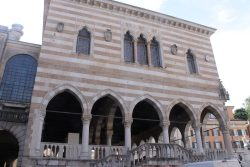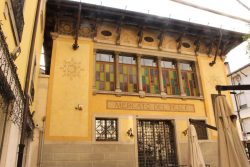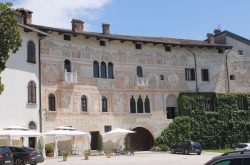 LIKE most regions of Italy, Friuli Venezia Giulia has no shortage of attractions for visitors but one of its most appealing is what is NOT there … hordes of tourists.
LIKE most regions of Italy, Friuli Venezia Giulia has no shortage of attractions for visitors but one of its most appealing is what is NOT there … hordes of tourists.
Friuli, as it is known – if it is known at all – is sometimes called ‘Secret Italy’ because of its location, perched at the country’s top right-hand corner abutting Austria to the north and Slovenia to the east.
Its main city, Trieste, has starred in countless Cold War spy thrillers down the years due to its proximity to the border with the former Yugoslavia.
 The nearby town of Gorizia, in fact, was sliced in two by its own mini ‘Berlin Wall’, guarded by sentries; nowadays a plaque shows the grim landmark.
The nearby town of Gorizia, in fact, was sliced in two by its own mini ‘Berlin Wall’, guarded by sentries; nowadays a plaque shows the grim landmark.
Friuli remains largely undiscovered despite its wealth of attractions. The Dolomite and Julian Alps dominate the north, while further south the landscape features numerous vineyards, reflecting the area’s wine-making reputation.
The region’s complex history began with the Romans when Aquileia was one of the largest and wealthiest cities of the Empire. Then Cividale  rose to prominence as the capital of a Lombard dukedom and the Venetians took control of Udine, now Friuli’s second city. However, it was the Habsburgs who had the greatest influence, with Trieste being a jewel in the crown of the Austro-Hungarian empire until it was ceded to Italy in 1918.
rose to prominence as the capital of a Lombard dukedom and the Venetians took control of Udine, now Friuli’s second city. However, it was the Habsburgs who had the greatest influence, with Trieste being a jewel in the crown of the Austro-Hungarian empire until it was ceded to Italy in 1918.
The fact that Friuli’s colourful past includes periods in both Austria and Yugoslavia is reflected, not only in its architecture, but also in its gastronomy, with menus listing dishes and flavours seldom if ever encountered elsewhere in Italy.
 Traveller’s tip: There are direct flights from the UK to Trieste and Venice, 90 miles away. The feeling is that Friuli is going to be ‘discovered’ before long so it would be a smart move to check out this unique corner of Italy before the crowds arrive.
Traveller’s tip: There are direct flights from the UK to Trieste and Venice, 90 miles away. The feeling is that Friuli is going to be ‘discovered’ before long so it would be a smart move to check out this unique corner of Italy before the crowds arrive.
 Pictures 1 and 2 – (top right) Trieste’s Piazza Unità d’Italia, Europe’s largest sea-facing square, features the smart cafés, with their inspiring sea views, once frequented by literary figures, such as James Joyce and Sigmund Freud.
Pictures 1 and 2 – (top right) Trieste’s Piazza Unità d’Italia, Europe’s largest sea-facing square, features the smart cafés, with their inspiring sea views, once frequented by literary figures, such as James Joyce and Sigmund Freud.
Picture 3 – (third right) Udine’s Venetian heritage can be seen in this beautiful loggia.
 Picture 4 – (fourth right) The colourful former fish market at Udine, now used as an arts centre.
Picture 4 – (fourth right) The colourful former fish market at Udine, now used as an arts centre.
Picture 5 – (fifth right) Miramare Castle was built in 1860 for the Archduke Maximilian of Habsburg and his wife, Charlotte of Belgium. Set dramatically on a rocky promontory above the sea, it has an immaculately  landscaped park, and breathtaking views over the gulf.
landscaped park, and breathtaking views over the gulf.
Picture 6 – (bottom right) The medieval castle at Spilimbergo. Some buildings were set ablaze during upheavals in 1511, but much of its painted façades were saved. There is also a 13th-century cathedral with frescoes, paintings and sculptures adorning its interior.
 Picture 7 – (top left) San Daniele, the region is famed for its high-quality prosciutto and its many prosciutto farms.
Picture 7 – (top left) San Daniele, the region is famed for its high-quality prosciutto and its many prosciutto farms.
Picture 8 – (centre left) Aquileia was one of the largest and wealthiest cities of the Roman Empire. Its Romanesque-Gothic basilica, a World Heritage site, was built on the ruins of a fourth-century church, and the original floor, paved with mosaics, is a sight  to behold.
to behold.
Picture 9 – (bottom left) Sant Ignazio church at Gorizia, on the Italian border with Slovenia. The town is the unlikely location of a mini ‘Berlin Wall’, which formed a division between East and West Europe during the Cold War years. This wall with its sentry boxes survived until 2004. Gorizia was under the Austro-Hungarian Empire, conquered by the Italians during the First World War and then divided in two after the Second World War, with East Gorizia in the former Yugoslavia.